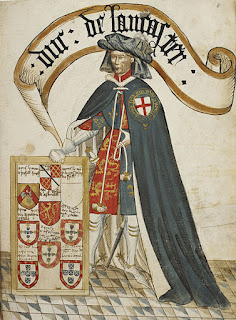In the public museum in Liverpool, England, is an exhibit of several gold medallions. They were found c.1844 in a grave at St. Martin's Church in Canterbury, the oldest Christian Saxon church in England still in use. One of these commemorates Bishop Liudhard; it was probably minted after his death but before the death of his patroness, Queen Bertha, in 601.
One side (shown here) shows a figure and the Latin inscription for Liudhard, "LEUDARDUS"; also included are the letters "EPS" denoting "EPiscopuS" (bishop). The obverse side shows a patriarchal cross: a cross with a smaller horizontal bar above the main crossbar. It is the earliest datable coin that depicts a patriarchal cross, especially one that has circles hanging from its arms.
The assumption, especially because each coin or medallion has a loop for hanging it as jewelry, is that they were part of a necklace from the grave of a woman who converted to Christianity. The other coins make for an interesting collection:
...an Italian tremissis of Justin II, a Germanic tremissis of unsure origin, a Merovingian solidus struck by Leudulf at Ivegio vico and two tremisses from southern France, the first from Saint-Bertrand-de-Comminges, the second from Agen. [link]
(A tremissis is a gold coin that is worth one-third of a solidus, hence the name which means "a third of a unit.")
The existence of the Liudhard medal requires us to see his presence in England as far more significant than the history books would typically suggest. His two-decade sojourn at the court of Æthelbert and Bertha must have made serious progress in spreading Christianity for him to have had a medallion made with his name.
After Liudhard's death, his remains were transferred from the churchyard of St. Martin's to the Church of St. Peter and St. Paul. That church was later converted to St. Augustine's Abbey. It is now a school, but let's take a look at its life as an abbey tomorrow.






















.jpg)





